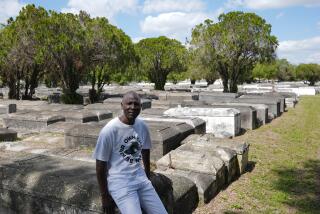Early Black Settlement Struggles to Preserve Heritage : History: Sandy Ground, on Staten Island, has shrunk to fewer than 15 families. It was formed by black freemen from Maryland in the 1820s.
- Share via
NEW YORK — Tucked away in the southwest corner of Staten Island, a church, a cemetery and a few parcels of land are all that remain of a once-vibrant community founded by a score of free black families from Maryland 160 years ago.
Where about 50 families flourished a century ago, fewer than 15 remain in the tight-knit enclave. But the hardy residents of Sandy Ground--one of the oldest black settlements in the United States--struggle to preserve vestiges of their proud heritage.
“It’s not the same thriving community that it once was, but we don’t feel that the community is dead, or that it’s lost,” said Yvonne Taylor, a 57-year-old fourth-generation descendant of Sandy Ground settlers.
Black freemen from Snow Hill on Maryland’s eastern shore formed the Sandy Ground settlement in the mid-1820s. Unhappy with that state’s laws restricting the rights of free blacks, the estimated 20 families settled on Staten Island’s southwestern shore, where they could pursue their primary trade of oystering. Commercial farmers grew strawberries, tomatoes and asparagus, selling their vegetables by the wagonload and later the truckload in Manhattan markets. Others became blacksmiths who made and repaired horseshoes, oyster rakes and oyster boats. Still others wove large baskets used to carry oysters.
While they carved out livelihoods, they also nurtured roots in the area. “They had a real sense of escaping a situation that was onerous and coming to a place where they could develop their own community,” said Richard Dickenson, Staten Island’s borough historian.
Soon they were joined by newly freed or escaped slaves from Virginia and Delaware, and later by black families, relatives and friends from New York, New Jersey and Connecticut. By then, Sandy Ground had become a spur of the Underground Railway.
In 1850 residents established the Zion African Methodist Episcopal Church as the “focal point” of the community, Dickenson said. The church, known today as the Rossville AME Zion Church, continues as the religious and social center of Sandy Ground, which is technically called Rossville.
By the turn of the century, Sandy Ground encompassed almost 2 square miles and had about 200 residents from almost 50 families. But in 1916, a series of typhoid epidemics traceable to the oyster beds prompted the New York Department of Health to ban oystering in the polluted New York Harbor. Some residents left the area; others had to find a new livelihood.
“They didn’t let it discourage them; they adapted,” said Taylor, whose grandfather was an oysterman.
Ironworkers who had made tools for the oyster industry converted to toolmaking for farming and other trades. Others went to work in area factories.
Some, like Joseph Bishop, were recognized for their contributions beyond Sandy Ground’s borders. Staten Island residents flocked to Bishop’s blacksmith shop to watch him forge ornamental iron, which can still be found in some of Staten Island’s older homes and churches.
The Bishop Forge was destroyed by fire in 1982, four years before Joseph Bishop’s death at age 81.
Sandy Ground residents recall with a shudder the 1963 fire that razed the homes of about half of Sandy Ground’s 25 families as it swept through Staten Island. The fire was caused by hot, dry conditions and made worse by low water pressure, which inhibited firefighters’ attempts to tame it.
Those who could not afford to rebuild their homes reluctantly moved away. After the fire, developers acquired large parcels of land.
Although Sandy Ground was given landmark status as a state and national historic site in 1974 and 1982, respectively, those designations cannot restrict developers who require no state or federal funds and who comply with New York City codes. “It doesn’t stop development, but it might slow it down,” Dickenson said.
Sandy Ground’s 2-acre cemetery--its plots bearing the names of longtime families like the Bishops, Landins, Moodys and Purnells--has New York City landmark status, which restricts development much more than state or national landmark designations, Dickenson said.
An important link to Sandy Ground’s past was severed when Will (Pops) Pedro--the community’s unofficial mayor, tour guide and oral historian--died three years ago at age 106.
The Sandy Ground Historical Society was formed in 1979 to safeguard the community’s remaining legacy. Sandy Ground’s historic-district status has enabled the society to obtain government grants to buy two parcels of land, one of them the old Bishop Forge property. The society also is purchasing a former resident’s house as its headquarters and library, said Lucille Herring, the society’s president and a granddaughter of Pedro.
There are other signs that Sandy Ground’s residents are committed to preserving their heritage. Although fewer than 50 descendants of the original settlers remain, some former residents are considering returning to the area, Taylor said.
The Rossville Church still attracts up to 50 congregants for Sunday services. Some of them travel more than an hour from their homes in New Jersey and New York.
Oprah Winfrey, the talk-show host, donated $10,000 last year to initiate a church library and education program for children of the area’s families.
The historical society also sponsors several annual events, including Family and Friends Day in June, when former residents return to renew friendships with current residents and friends.
More to Read
Sign up for Essential California
The most important California stories and recommendations in your inbox every morning.
You may occasionally receive promotional content from the Los Angeles Times.













